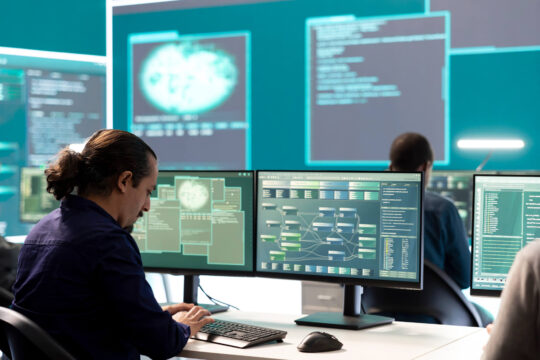Using Technology to Step Up Post-COVID Security
Law enforcement agencies have seen a sharp uptick in the number of mass shootings in recent years. According to a USA Today analysis, mass shootings surged with a 47% increase in 2020 over the previous year. This was happening before the pandemic, but part of it clearly seems to be due to COVID-19 and the psychological and logistical impacts of lockdowns, lost jobs and changing political landscapes.
COVID or no COVID, long gone are the days when you could see a horrible news story and believe it will never happen to you or your organization. You can’t just sit around and wait for it to happen. Especially if your organization is welcoming employees and customers back to physical venues after the pandemic. This sudden new intensity is a perfect time to devote generous attention to security plans.
Modern technology and training reduce the likelihood of a violent event and reduce the potential impact. According to Prime Secured’s COO and security expert, Jamie Bumgardner, the most effective defense you can offer your organization is the institution of a well-thought-out two-step approach: prevention and action. This includes assessing protocols, technology and training, as well as making sure your staff knows the correct actions to take, and when.
Many organizations have plans in place for these kinds of events, but both plans and technology are often outdated. In some cases, equipment has gone unused for a long time, has never been tested and no longer functions. In the most egregious cases, subpar disaster plans involve contacting someone who no longer works at the company!
Prime partners with safety training firm, Safe Passage Consulting to assist organizations in upgrading security and developing comprehensive steps for effective safety plans. In this article, we outline the basics as a baseline to help you bring your own organization up to speed.
STEP 1: Preparation
The best thing you can do for your organization to effectively mitigate potentially violent events is to be prepared. This seems obvious, but it’s often taken for granted—and it’s not always true even if you believe you are prepared.
With proper, up-to-date technology and training, you may be able to prevent an attack from occurring in the first place. If the event itself cannot be prevented, updates will give everyone the best chance at survival, and that, of course, is the bottom line. “You can use technology and training as a force multiplier to keep people as safe as possible,” Bumgardner said.
Technology
Security technology experts work hard day after day, developing new ways to keep people safe and fine-tuning existing tech so it’s more efficient and reliable. If you are a security professional or company leader, it behooves you to also keep up with available technology to keep your people safe. The most heartbreaking part of any disaster is realizing too late you could have done more to save lives.
One example of recent technology advances is license plate readers. These have come a long way in function and reliability. A well-positioned camera can automatically check license plates of vehicles and cross reference them with databases of bad actors. If a vehicle belongs to a past offender or someone else who’s likely to cause trouble (e.g., a disgruntled former employee), you can be notified before they reach the building and potentially stop the problem there.
If the worst-case scenario happens and a shooting occurs, a gunshot detection system can quickly provide a wealth of information about the event. It can tell you where a weapon was fired, the direction the shooter was moving and even the caliber of the weapon. These systems are finely tuned to only register gunshots and won’t mistake a dropped pallet or other loud noise for a real emergency—even firing a blank won’t set them off.
Once you know a violent event is in process, a mass communication system can keep everyone informed of what’s happening, where it’s happening and what actions to take. You cannot only send messages to staff, but you also can equip phones with a panic button to notify security staff and law enforcement of threats. With the press of a button, a phone can turn into a video and audio recording device to capture and relay valuable information. This system can be useful in other dangerous situations such as earthquakes or fires.
Training
With mass shootings and other violent events occurring more frequently, most of us have at least idly considered what we would do in a dangerous situation. Whether your daydreams feature you heroically engaging an attacker in hand-to-hand combat or leaping out a window to a quick escape, people who are thrust into real situations rarely have the skills to execute these plans.
Furthermore, in a building with a large number of people present, even if each individual’s plan would work, everyone reacting to their own ideas at once creates chaos. What’s more, many organizations are still following outdated or inaccurate training, and it’s getting people hurt. To do everything you can to keep people safe, you need an up-to-date, standard, practiced plan that allows you to effectively communicate.
An integration team can help identify vulnerabilities in your plan (and in your technology), mitigate the problems, write a new plan, then train staff on equipment, protocols AND execution of the plan during a violent event.
Safe Passage’s Dustin Randall says the most effective aspect of training is often scenario practice. The team will train members of your staff, then put them into realistic situations to help them internalize what they have learned, increasing the odds that they’ll act appropriately when needed.
“It is often the debriefing that is the most valuable, when people look back on the scenario and realize what they could have done differently—and discuss the plan with colleagues,” Randall said.
STEP 2: Action
To have the best chance at survival, it’s necessary to take action of some kind. Theodore Roosevelt said “In any moment of decision, the best thing you can do is the right thing, the next best thing is the wrong thing, and the worst thing you can do is nothing.”
Once you’ve done everything you can ahead of time to give the people in your organization the best chance at preventing a violent event, you need to think about what everyone needs to do when an actual event occurs. According to Randall, staff should be trained to take these actions in this order:
Accept the Inevitable
Some people, when caught in violent incidents, will do anything to deny what’s happening. They may hear a gunshot and immediately assume it’s a car backfiring or fireworks—even if they have the experience to know the difference. It’s important to acknowledge when a threat is real and respond appropriately. Good training makes it more likely staff will act in a way that saves lives.
Run the Opposite Way
Many people freeze when faced with a threat they didn’t expect. But doing nothing is likely to get you hurt. Many existing plans tell staff to hide in a violent situation, but Randall explains that more people die if everyone hides instead of running. Remove yourself from the situation as fast as you can, find a safe place (hopefully, a pre-arranged meeting point) and contact police. Police responses have gotten much faster since active shooter situations have increased, but there’s no guarantee officers will immediately be able to find a shooter or obstruct the shooter’s path, so your priority is to leave.
As A Last Resort, Fight
No one expects your staff to be heroes—fighting an attacker is a last, desperate option. Safe Passage training teaches you to stay calm and take actions that give you a chance to live. If you find yourself facing an attacker, they suggest first throwing something at the attacker to distract them and then run as they duck. If all other options are gone, grab the gun by the barrel and face it away from you. “Always remember, there are usually more of you than them. You can band together and pile on an attacker to subdue them,” Randall said.
Keep the Security Update Cycle Going - Indefinitely
The combined Prime/Safe Passage expert team suggests continually renewing these steps over time—whether during a pandemic, after an uptick in violence, or any time. Then you’ll know for certain you and your staff have done everything you can to make efficient use of the technology and training available. If, heaven forbid, you and your organization ever have to face a real situation, imagine how rewarding it will feel to know you’ve done everything you could do to reduce the odds of disaster.
For more information about our combined technology and training services, please contact Prime Secured at 402-289-4126 or at primesecured.com We are happy to have a preliminary discussion with you about your security and training needs.




